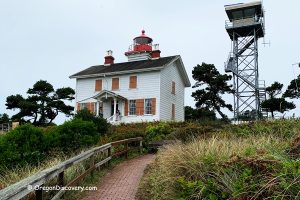
Lore and Legends from Christopher Klimovitz
I am drawn to lighthouses and how they sit on a liminal edge between the unknown and the known. I think that if I lived in the Victorian era, I might have been a keeper, but the dangers of such a profession cannot be overstated. It is this draw that brought me to Heceta Head Lighthouse on 30 March 2022, on the anniversary of its principal lighting.
Heceta Head sits on top of a 1,000-foot-high cliff that overlooks the Pacific Ocean. The tower is 56-feet tall and has a 21-mile 2-ton Fresnel light that still stands as the strongest light in Oregon.
Getting to Heceta Head proved difficult that day because my brother-in-law’s car broke down in Mapleton and if it wasn’t for the kindness of the people of Mapleton and Florence, I think that my wife and I would have been stranded.
After many harrowing hours, we finally made it to Heceta, a place that I have wanted to see since I was a boy. I first learned about this light growing up in the Delmarva Peninsula of the East Coast because of ghost shows that my dad and I would watch.
The drive to Heceta is winding and surrounded by coniferous forests, sea lion coves, and orca whales gracefully cutting through the tempestuous Pacific. The lighthouse first shone 30 March 1894 and has been home to many keepers and their families. The light is named after Bruno de Heceta, whom was a Portuguese or Basque sailor under the Spanish flag and saw the cape in 1775.

The Spanish were seeking new colonies in a geopolitical race against the British, French, Russians, and later the Americans. The waters around here are notorious and have claimed many mariners over the centuries. In fact, just days before I arrived for the anniversary of the light, there was a fisherman and fisherwoman who lost their lives in a storm just in eyesight of Heceta Head.
That is why lighthouses still serve a common good to the public, even though they are largely automated. And it is this recognition of their continued service that they are celebrated. Each 30 March, the now bed and breakfast opens its doors to the public with a barbecue, Victorian music and fanfare, and a tour of the base of the lighthouse.
Unfortunately, years of wear and tear has dislodged the spiral stairs from the tower making it unsafe for the public to climb. I had the grand opportunity to view the old rooms where keepers and their families called home and how they spent their lives.
The life of a keeper and family was mostly a quiet and isolated life punctured by harrying events that kept one on their toes. It was an existence for the iron willed and not faint of heart. One also had to be accepting of the doldrums of life here, which have spawned ghostly tales.
To be considered in the academic study of Folklorics, a story must be replicable among larger communities and have some moral framework. Unfortunately, many places feed off their ghostly and dark hype and encourage false stories and narratives with no historical basis.
A great example of this cottage industry is some slave plantations that thrive on ghost stories. They murk the reality of the real horrors with fake legends.

Many places are terrifying and fascinating enough without baggage. As in all my writings as a skeptic, my goal is not to continue this industry but to bring more critical thought to the stories.
At Heceta Head, some of the docents openly talk about their supposed haunted guests, but I appreciated that they don't push the stories as some locations do.
There is a trope in the folklore of an apparition of a spectral woman, and these stories are found worldwide. At Heceta Head, she is known as a Victorian grey lady named "Rue", discovered because of an Ouija board session (I'll save my eye-rolling views of Ouija boards for another time) years ago.
There are many versions of this story, and what helps it stick is that record-keeping of wives and children at lighthouses wasn't a thing in the Victorian and Edwardian eras.
For example, a gravestone of a drowned young child was found in the woods near the light. While we know it is connected to the lighthouse, we don't know who the child was.
It is said that Rue likes to keep a clean house, even when a window breaks and sweeps up the mess. That is a very handy ghost. There are also stories of a spirit getting in bed with patrons and giving them a scare.
Again, these stories are word of mouth and change with retellings, but they give Heceta Head Lighthouse extra character. And can you blame such a beautiful place for not having a few strange stories about spooky denizens? The stories practically write themselves.
You May Also Like









